HONDA PASSPORT 2001 2.G Owner's Manual
Manufacturer: HONDA, Model Year: 2001, Model line: PASSPORT, Model: HONDA PASSPORT 2001 2.GPages: 317, PDF Size: 4.85 MB
Page 21 of 317

W
e recommen d tha t a pregnan t
woma n us e a lap/shoulde r bel t
wheneve r possible . Remembe r t o
kee p th e la p portio n o f th e bel t a s
lo w a s possibl e acros s you r hips .
Pregnan t wome n shoul d als o si t a s
fa r bac k a s possibl e fro m th e
steerin g whee l o r dashboard . Thi s
wil l reduc e th e ris k o f injurie s t o
bot h th e mothe r an d he r unbor n
chil d tha t ca n b e cause d b y a
cras h o r a n inflatin g airbag .
Eac h tim e yo u hav e a checkup ,
ask you r docto r i f it' s oka y fo r
yo u t o drive .
Additiona l Safet y
Precaution s
Two
people should never use
the same seat belt. If the y do ,
the y coul d b e ver y seriousl y
injure d in a crash .
Do
not put any accessories on
seat belts. Device s intende d to
improv e occupan t comfort , o r
repositio n th e shoulde r par t o f a
sea t belt , ca n severel y
compromis e th e protectiv e
capabilit y o f th e sea t bel t an d
increas e th e chanc e o f seriou s
injur y i n a crash .
Do
not place hard or sharp
objects between yourself and
a n airbag. Carryin g har d o r
shar p object s o n you r lap , o r
drivin g wit h a pip e o r othe r
shar p objec t i n you r mouth , ca n
resul t i n injurie s i f you r airbag s
inflate .
Keep your hands and arms
away from the airbag covers.
I f you r hand s o r arm s ar e clos e
t o th e SR S cover s i n th e cente r
o f th e steerin g whee l o r o n to p
o
f th e dashboard , the y coul d b e
injure d if th e airbag s inflate .
Never let passengers ride in
the cargo area or on top of a
folded-down back seat. All
passenger s mus t si t i n locked ,
uprigh t seat s an d b e properl y
restraine d b y sea t belts .
Do
not attach or place objects
o n the airbag covers. Any
objec t attache d t o o r place d o n
th e cover s marke d "SR S
AIRBAG " i n th e cente r o f th e
steerin g whee l an d o n to p o f
th e dashboar d coul d interfer e
wit h th e prope r operatio n o f th e
airbags . Or , i f th e airbag s
inflate , th e object s coul d b e
propelle d insid e th e ca r an d
hur t someone .
Drive r an d Passenge r Safet y
Page 22 of 317
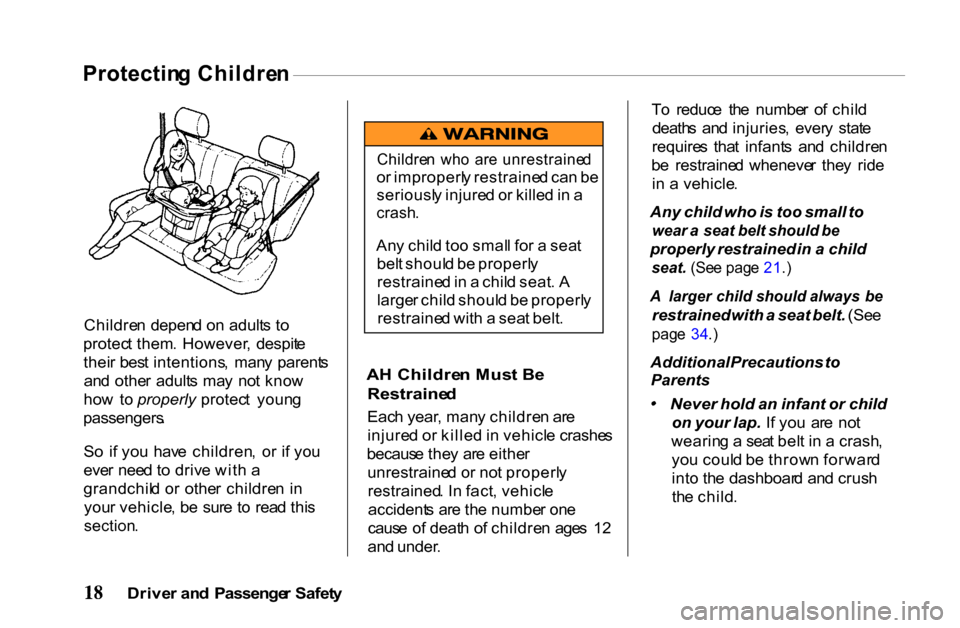
Protectin
g Childre n
Childre n depen d o n adult s t o
protec t them . However , despit e
thei r bes t intentions , man y parent s
an d othe r adult s ma y no t kno w
ho w to properly protect youn g
passengers .
S o i f yo u hav e children , o r i f yo u
eve r nee d t o driv e wit h a
grandchil d o r othe r childre n i n
you r vehicle , b e sur e t o rea d thi s
section .
A
H Childre n Mus t B e
Restraine d
Eac h year , man y childre n ar e
injure d o r kille d in vehicl e crashe s
becaus e the y ar e eithe r
unrestraine d o r no t properl y
restrained . I n fact , vehicl e
accident s ar e th e numbe r on e
caus e o f deat h o f childre n age s 1 2
an d under . T
o reduc e th e numbe r o f chil d
death s an d injuries , ever y stat e
require s tha t infant s an d childre n
b e restraine d wheneve r the y rid e
i n a vehicle .
Any child who is too small to
wear a seat belt should be
properly restrained in a child
seat. (See pag e 21 .)
A larger child should always be
restrained with a seat belt. (See
pag e 34 .)
Additional Precautions to
Parents
Never hold an infant or child
o n your lap. If yo u ar e no t
wearin g a sea t bel t i n a crash ,
yo u coul d b e throw n forwar d
int o th e dashboar d an d crus h
th e child .
Drive r an d Passenge r Safet y
Childre
n wh o ar e unrestraine d
o r improperl y restraine d ca n b e
seriousl y injure d o r kille d in a
crash .
An y chil d to o smal l fo r a sea t
bel t shoul d b e properl y
restraine d in a chil d seat . A
large r chil d shoul d b e properl y
restraine d wit h a sea t belt .
Page 23 of 317
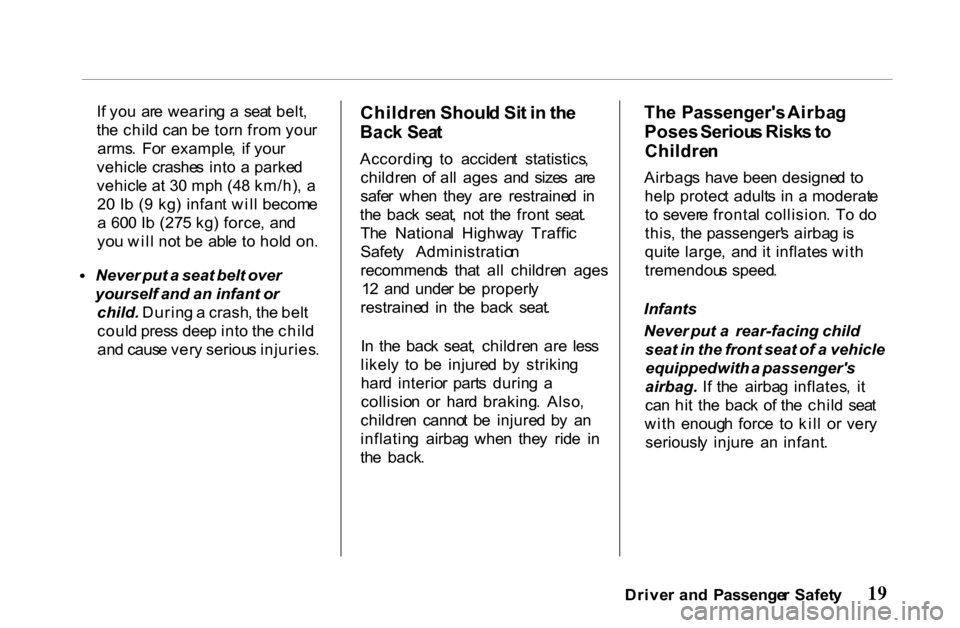
I
f yo u ar e wearin g a sea t belt ,
th e chil d ca n b e tor n fro m you r
arms . Fo r example , i f you r
vehicl e crashe s int o a parke d
vehicl e a t 3 0 mp h (4 8 km/h) , a
2 0 I b ( 9 kg ) infan t wil l becom e
a 60 0 I b (27 5 kg ) force , an d
yo u wil l no t b e abl e t o hol d on . Never
put a seat belt over
yourself and an infant or
child. Durin g a crash , th e bel t
coul d pres s dee p int o th e chil d
an d caus e ver y seriou s injuries .Childre
n Shoul d Si t i n th e
Bac k Sea t
Accordin g t o acciden t statistics ,
childre n o f al l ages and size s ar e
safe r whe n the y are restraine d i n
th e bac k seat , no t th e fron t seat .
Th e Nationa l Highwa y Traffi c
Safet y Administratio n
recommend s tha t al l childre n ages
1 2 an d unde r b e properl y
restraine d i n th e bac k seat .
I n th e bac k seat , childre n are les s
likel y t o b e injure d b y strikin g
har d interio r part s durin g a
collisio n o r har d braking . Also ,
childre n canno t b e injure d b y a n
inflatin g airba g whe n the y rid e i n
th e back .
Th
e Passenger's Airbag
Poses Seriou s Risk s to
Childre n
Airbag s hav e bee n designe d t o
hel p protec t adult s i n a moderat e
t o sever e fronta l collision . T o d o
this , th e passenger' s airba g is
quit e large , an d i t inflate s wit h
tremendou s speed .
Infants
Never put a rear-facing child
seat in the front seat of a vehicle
equipped with a passenger's
airbag. If th e airba g inflates , i t
ca n hi t th e bac k o f th e chil d sea t
wit h enoug h forc e t o kil l o r ver y
seriousl y injur e a n infant .
Drive r an d Passenge r Safet y
Page 24 of 317
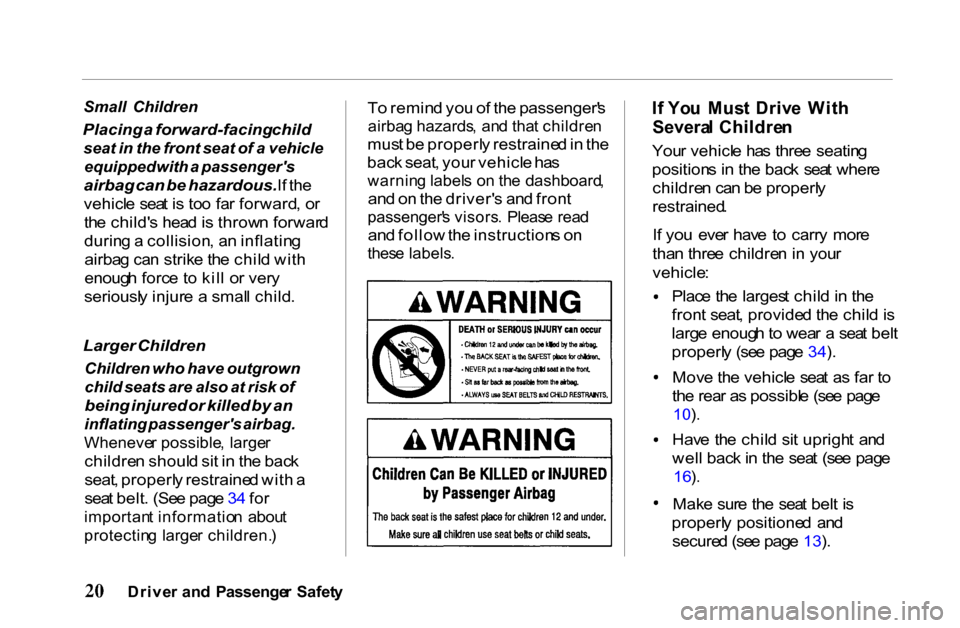
Small
Children
Placing a forward-facing child
seat in the front seat of a vehicle
equipped with a passenger's
airbag can be hazardous. If th e
vehicl e sea t i s to o fa r forward , o r
th e child' s hea d is throw n forwar d
durin g a collision , a n inflatin g
airba g ca n strik e th e chil d wit h
enoug h forc e t o kil l o r ver y
seriousl y injur e a smal l child .
Larger Children
Children who have outgrown
child seats are also at risk of
being injured or killed by an
inflating passenger's airbag.
Wheneve r possible , large r
childre n shoul d si t i n th e bac k
seat , properl y restraine d wit h a
sea t belt . (Se e pag e 3 4 fo r
importan t informatio n abou t
protectin g large r children. )
T
o remin d yo u o f th e passenger' s
airba g hazards , an d tha t childre n
mus t b e properl y restraine d in th e
bac k seat , you r vehicl e ha s
warnin g label s o n th e dashboard ,
an d o n th e driver' s an d fron t
passenger' s visors . Pleas e rea d
an d follo w th e instruction s o n
thes e labels .
I
f Yo u Mus t Driv e Wit h
Severa l Childre n
You r vehicl e ha s thre e seatin g
position s i n th e bac k sea t wher e
childre n ca n b e properl y
restrained .
I f yo u eve r hav e t o carr y mor e
tha n thre e childre n in you r
vehicle : Plac
e th e larges t chil d in th e
fron t seat , provide d th e chil d is
larg e enoug h to wea r a sea t bel t
properl y (se e pag e 34 ).
Mov e th e vehicl e sea t a s fa r t o
th e rea r a s possibl e (se e pag e
10 ).
Hav e th e chil d si t uprigh t an d
wel l bac k in th e sea t (se e pag e
16 ).
Mak e sur e th e sea t bel t i s
properl y positione d an d
secure d (se e pag e 13 ).
Drive r an d Passenge r Safet y
Page 25 of 317
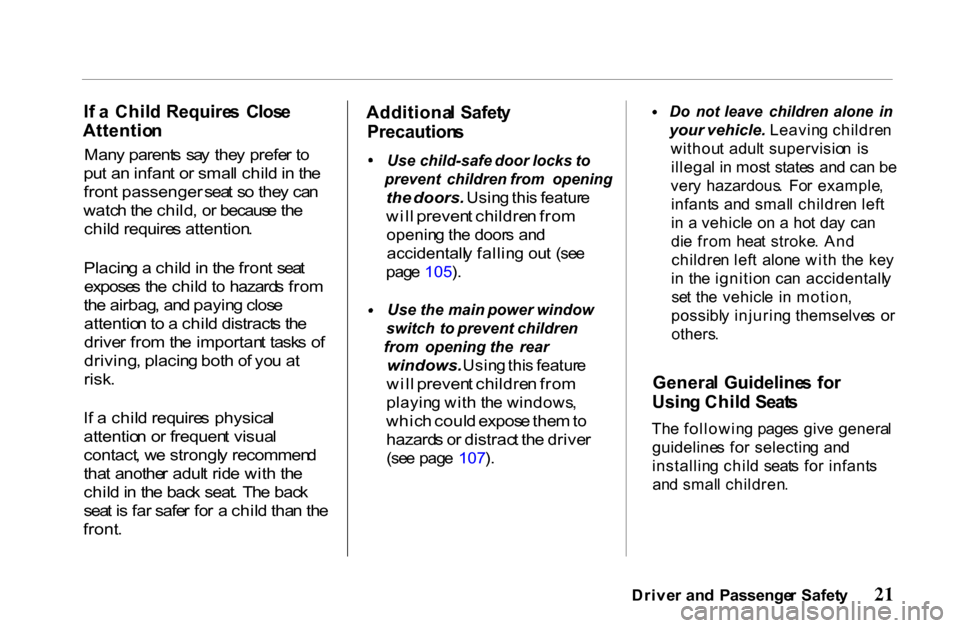
I
f a Chil d Require s Clos e
Attentio n
Man y parent s sa y the y prefe r t o
pu t a n infan t o r smal l chil d in th e
fron t passenger seat s o the y ca n
watc h th e child , o r becaus e th e
chil d require s attention .
Placin g a chil d in th e fron t sea t
expose s th e chil d to hazard s fro m
th e airbag , an d payin g clos e
attentio n to a chil d distract s th e
drive r fro m th e importan t task s o f
driving , placin g bot h o f yo u a t
risk .
I f a chil d require s physica l
attentio n o r frequen t visua l
contact , w e strongl y recommen d
tha t anothe r adul t rid e wit h th e
chil d in th e bac k seat . Th e bac k
sea t i s fa r safe r fo r a chil d tha n th e
front .
Additiona
l Safet y
Precaution s
Use
child-safe door locks to
prevent children from opening
the doors. Using thi s featur e
wil l preven t childre n fro m
openin g th e door s an d
accidentall y fallin g ou t (se e
pag e 105 ).
Use
the main power window
switch to prevent children
from opening the rear
windows. Using thi s featur e
wil l preven t childre n fro m
playin g wit h th e windows ,
whic h coul d expos e the m to
hazard s o r distrac t th e drive r
(se e pag e 107 ).
Do
not leave children alone in
your vehicle. Leaving childre n
withou t adul t supervisio n i s
illega l i n mos t state s an d ca n b e
ver y hazardous . Fo r example ,
infant s an d smal l childre n lef t
i n a vehicl e o n a ho t da y ca n
di e fro m hea t stroke . An d
childre n lef t alon e wit h th e ke y
i n th e ignitio n ca n accidentall y
se t th e vehicl e i n motion ,
possibl y injurin g themselve s o r
others .
Genera l Guideline s fo r
Usin g Chil d Seat s
Th e followin g page s giv e genera l
guideline s fo r selectin g an d
installin g chil d seat s fo r infant s
an d smal l children .
Drive r an d Passenge r Safet y
Page 26 of 317
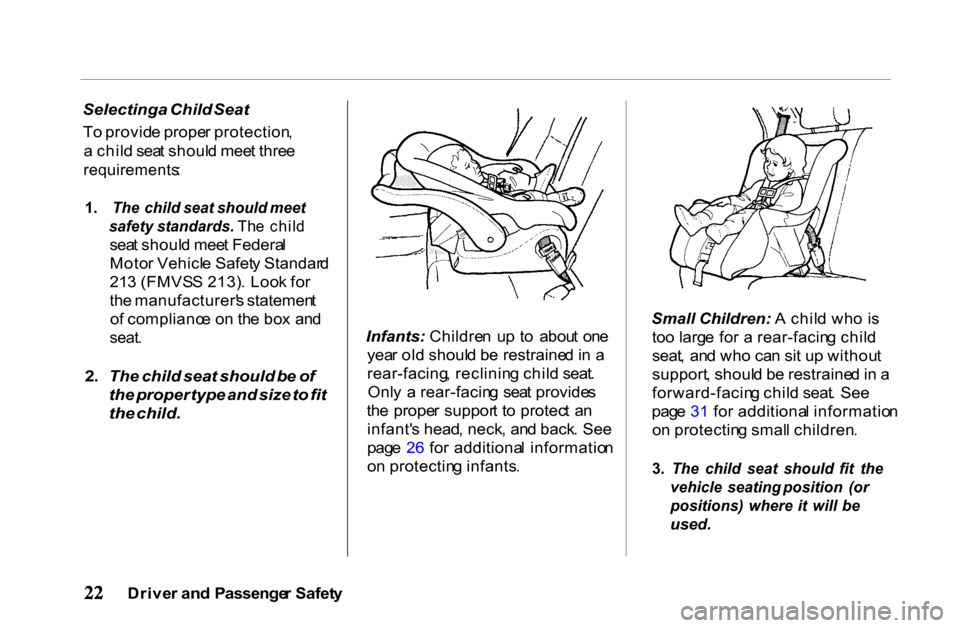
Selecting
a Child Seat
T o provid e prope r protection ,
a chil d sea t shoul d mee t thre e
requirements :
1 . The child seat should meet
safety standards. The chil d
sea t shoul d mee t Federa l
Moto r Vehicl e Safet y Standar d
21 3 (FMVS S 213) . Loo k fo r
th e manufacturer' s statemen t
o f complianc e o n th e bo x an d
seat .
2 . The child seat should be o f
the proper type and size to fit
the child.
Infants:
Childre n u p t o abou t on e
yea r ol d shoul d b e restraine d in a
rear-facing , reclinin g chil d seat .
Onl y a rear-facin g sea t provide s
th e prope r suppor t t o protec t a n
infant' s head , neck , an d back . See
pag e 2 6 fo r additiona l informatio n
o n protectin g infants . Small
Children: A chil d wh o i s
to o larg e fo r a rear-facin g chil d
seat , an d wh o ca n si t u p withou t
support , shoul d b e restraine d in a
forward-facin g chil d seat . See
pag e 3 1 fo r additiona l informatio n
o n protectin g smal l children .
3 . The child seat should fit the
vehicle seating position (or
positions) where it will be
used.
Drive r an d Passenge r Safet y
Page 27 of 317
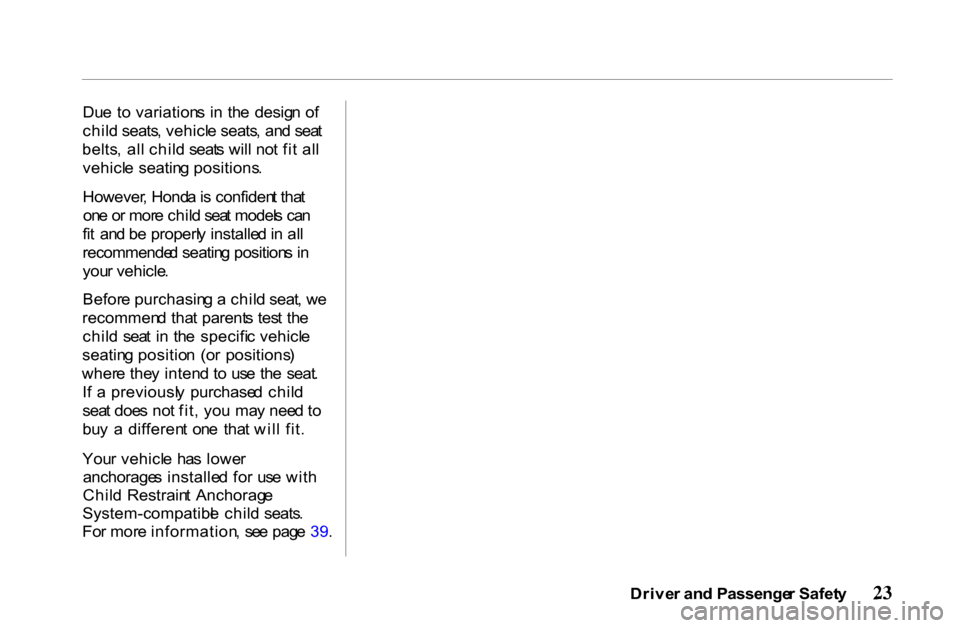
Du
e t o variation s i n th e desig n o f
chil d seats , vehicl e seats , an d sea t
belts , al l chil d seat s will no t fi t al l
vehicl e seatin g positions .
However , Hond a is confiden t tha t
on e o r mor e chil d sea t model s ca n
fi t an d b e properl y installe d in al l
recommende d seatin g position s in
you r vehicle .
Befor e purchasin g a chil d seat , w e
recommen d tha t parent s tes t th e
chil d sea t i n th e specifi c vehicl e
seatin g positio n (o r positions )
wher e the y inten d t o us e th e seat .
I f a previousl y purchase d chil d
sea t doe s no t fit , yo u ma y nee d to
bu y a differen t on e tha t wil l fit .
You r vehicl e ha s lowe r
anchorage s installe d fo r us e wit h
Chil d Restrain t Anchorag e
System-compatibl e chil d seats .
Fo r mor e information , se e pag e 39 .
Driver an d Passenge r Safet y
Page 28 of 317
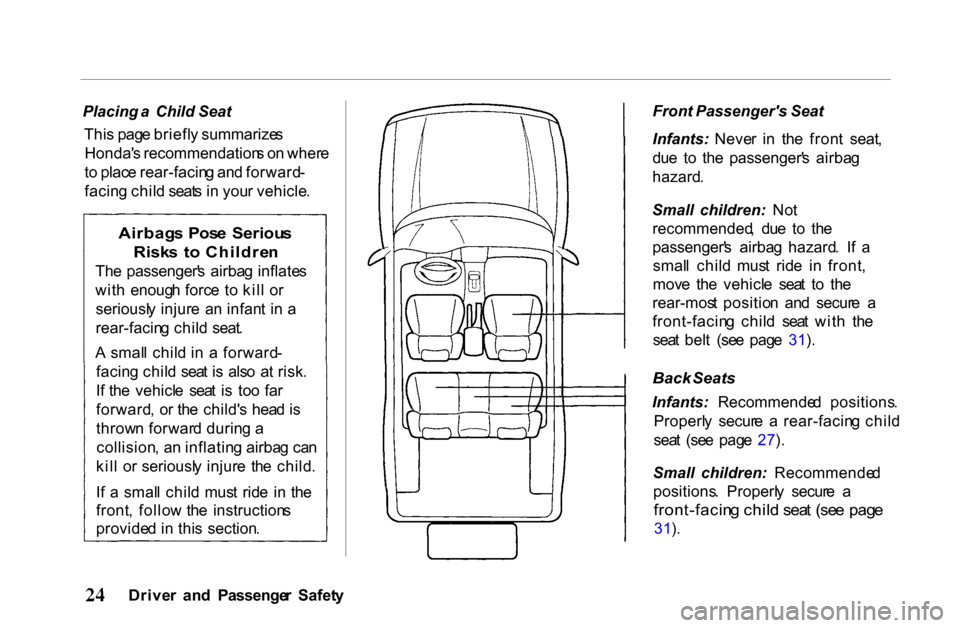
Placing
a Child Seat
Thi s pag e briefl y summarize s
Honda' s recommendation s o n wher e
t o plac e rear-facin g an d forward -
facin g chil d seat s i n you r vehicle . Front
Passenger's Seat
Infants: Never i n th e fron t seat ,
du e t o th e passenger' s airba g
hazard .
Small children: Not
recommended , du e t o th e
passenger' s airba g hazard . I f a
smal l chil d mus t rid e i n front ,
mov e th e vehicl e sea t t o th e
rear-mos t positio n an d secur e a
front-facin g chil d sea t wit h th e
sea t bel t (se e pag e 31 ).
Back Seats
Infants: Recommende d positions .
Properl y secur e a rear-facin g chil d
sea t (se e pag e 27 ).
Small children: Recommende d
positions . Properl y secur e a
front-facin g chil d sea t (se e pag e
31 ).
Drive r an d Passenge r Safet y
Airbag
s Pos e Seriou s
Risk s t o Childre n
Th e passenger' s airba g inflate s
wit h enoug h forc e t o kil l o r
seriousl y injur e a n infan t i n a
rear-facin g chil d seat .
A smal l chil d i n a forward -
facin g chil d sea t i s als o a t risk .
I f th e vehicl e sea t i s to o fa r
forward , o r th e child' s hea d is
throw n forwar d durin g a
collision , a n inflatin g airba g ca n
kil l o r seriousl y injur e th e child .
I f a smal l chil d mus t rid e i n th e
front , follo w th e instruction s
provide d i n thi s section .
Page 29 of 317
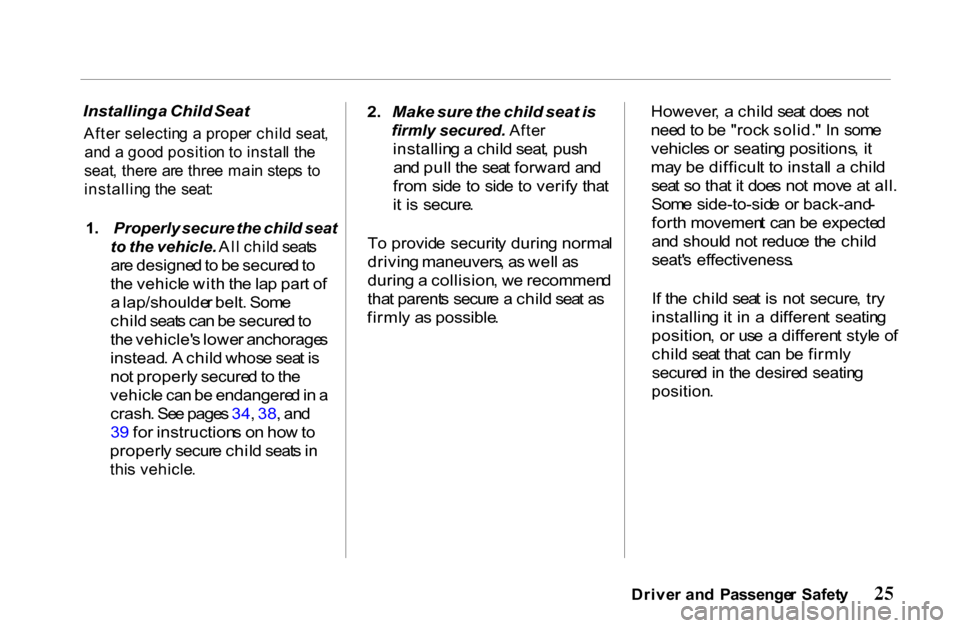
Installing
a Child Seat
Afte r selectin g a prope r chil d seat ,
an d a goo d positio n t o instal l th e
seat , ther e ar e thre e mai n step s t o
installin g th e seat :
1 . Properly secure the child seat
to the vehicle. All chil d seat s
ar e designe d to b e secure d to
th e vehicl e wit h th e la p par t o f
a lap/shoulde r belt . Som e
chil d seat s ca n b e secure d to
th e vehicle' s lowe r anchorage s
instead . A chil d whos e sea t i s
no t properl y secure d to th e
vehicl e ca n b e endangere d in a
crash . Se e page s 34 , 38 , an d
3 9 fo r instruction s o n ho w to
properl y secur e chil d seat s in
thi s vehicle .
2
. Make sure the child seat is
firmly secured. After
installin g a chil d seat , pus h
an d pul l th e sea t forwar d an d
fro m sid e t o sid e t o verif y tha t
i t i s secure .
T o provid e securit y durin g norma l
drivin g maneuvers , a s wel l a s
durin g a collision , w e recommen d
tha t parent s secur e a chil d sea t a s
firml y a s possible . However
, a chil d sea t doe s no t
nee d to b e "roc k solid. " I n som e
vehicle s o r seatin g positions , i t
ma y b e difficul t t o instal l a chil d
sea t s o tha t i t doe s no t mov e a t all .
Som e side-to-sid e o r back-and -
fort h movemen t ca n b e expecte d
an d shoul d no t reduc e th e chil d
seat' s effectiveness .
I f th e chil d sea t i s no t secure , tr y
installin g it i n a differen t seatin g
position , o r us e a differen t styl e o f
chil d sea t tha t ca n b e firml y
secure d in th e desire d seatin g
position .
Drive r an d Passenge r Safet y
Page 30 of 317
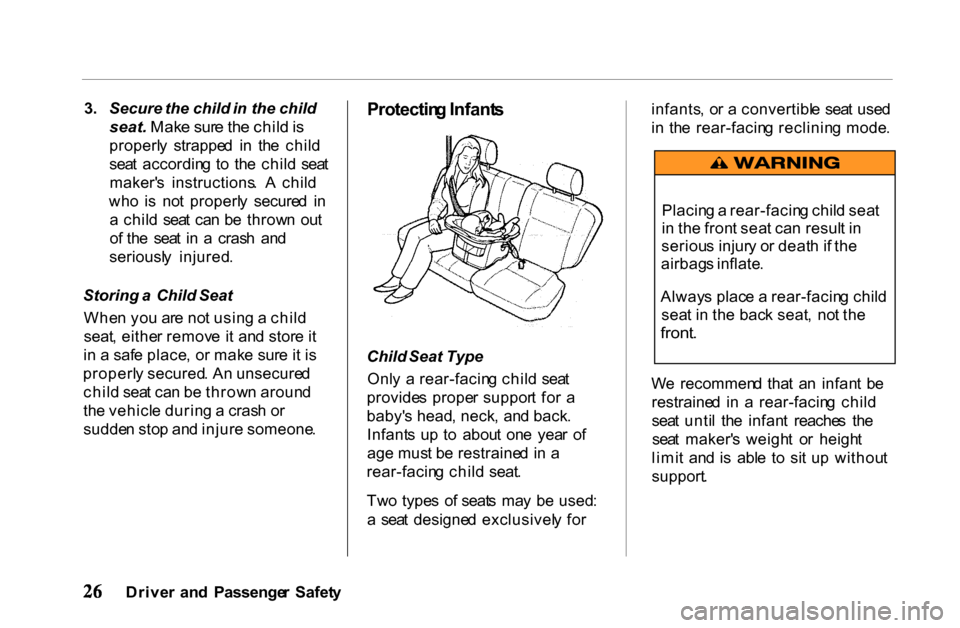
3
. Secure the child in the child
seat. Make sur e th e chil d is
properl y strappe d i n th e chil d
sea t accordin g t o th e chil d sea t
maker' s instructions . A chil d
wh o i s no t properl y secure d i n
a chil d sea t ca n b e throw n ou t
o f th e sea t i n a cras h an d
seriousl y injured .
Storing a Child Seat
Whe n yo u ar e no t usin g a chil d
seat , eithe r remov e i t an d stor e it
i n a saf e place , o r mak e sur e it i s
properl y secured . A n unsecure d
chil d sea t ca n b e throw n aroun d
th e vehicl e durin g a cras h o r
sudde n sto p an d injur e someone .
Protectin
g Infant s
Child Seat Type
Onl y a rear-facin g chil d sea t
provide s prope r suppor t fo r a
baby' s head , neck , an d back .
Infant s u p t o abou t on e yea r o f
age mus t b e restraine d i n a
rear-facin g chil d seat .
Tw o type s o f seat s ma y b e used :
a sea t designe d exclusivel y fo r infants
, o r a convertibl e sea t use d
i n th e rear-facin g reclinin g mode .
W e recommen d tha t a n infan t b e
restraine d i n a rear-facin g chil d
sea t unti l th e infan t reache s th e
sea t maker' s weigh t o r heigh t
limi t an d i s abl e t o si t u p withou t
support .
Drive r an d Passenge r Safet y Placin
g a rear-facin g chil d sea t
i n th e fron t sea t ca n resul t i n
seriou s injur y o r deat h if th e
airbag s inflate .
Alway s plac e a rear-facin g chil d
sea t i n th e bac k seat , no t th e
front .